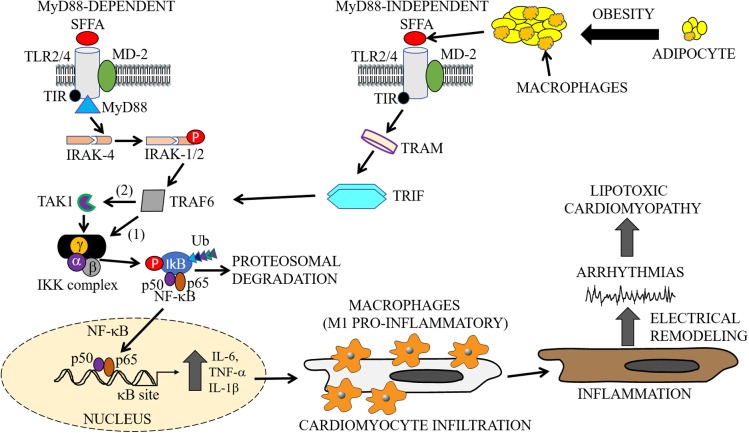FIGURE 2.
Cardiac and macrophage inflammatory pathways. In metabolic disorders, enlargement of adipocytes contributes to the activation of macrophages and release of SFFAs through lipolysis (Watanabe et al., 2013). The exposure of cells to increased levels of these inflammatory molecules leads to the activation of inflammatory pathways. The cartoon representation shows the activation of the TLR signaling pathways (MyD88-dependent and -independent), by SFFAs in both macrophages and cardiomyocytes. Infiltration of cardiomyocytes by M1 pro-inflammatory macrophages may lead to cardiac electrical dysfunction, cause arrythmias leading to cardiomyopathies of metabolic disorders. The MyD88-dependent pathway involves sequentially, activation of IRAK4, phosphorylation of IRAK1/2, and TRAF6, followed by activation of IKK and NF-κB, and the subsequent production or secretion of pro-inflammatory cytokines (IL-6, TNF-α, IL-1β). The MyD88-independent pathway also involves the secretion of pro-inflammatory cytokines through activation of TRAF6 by TRAM/TRIF. SFFA, Saturated free-fatty acid; TLR, Toll-like receptor; MD-2, myeloid differentiation protein-2; TIR, Toll/interleukin-1 receptor; TRIF, TIR-domain-containing adapter-inducing interferon-β; TRAM, TRIF-related adapter molecule; TRAF, tumor necrosis factor receptor-associated factor; IRAK, interleukin-1 receptor-associated kinase; TAK, transforming growth factor β activated kinase; IKK, inhibitory kappa B alpha kinase; NF-κB, nuclear factor-kappa B; Ub, ubiquitin.

